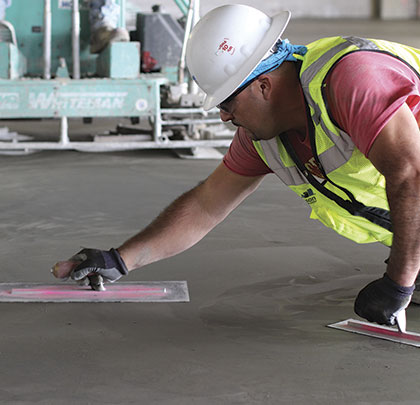Most owners, designers, and contractors are familiar with the concept of moisture mitigation. What isn’t always understood is the gravity of what moisture mitigation will do for a facility or what could happen if it’s neglected. Concrete construction, for good reason, is at the center of the moisture mitigation conversation. From flooring failures and liabilities to the serious implications of sick building syndrome (SBS), tackling the issues of excess moisture in concrete slabs can’t be ignored.
UNWANTED COMBINATION
While water is a requirement for the formation of any concrete mix, the extent to which it retains moisture can vary wildly based upon the mix used or environmental factors. The target relative humidity level (RH) before flooring can be safely placed is 80 percent or lower. Most flooring subcontractors will have expectations that the RH will reach target levels before installation can begin or a warranty is applied. Trapped moisture can migrate to the surface of a concrete slab and severely warp flooring materials, costing owners thousands of dollars in repairs. In short, concrete slabs and moisture are an unwanted combination.
SICK BUILDING SYNDROME
Moisture trapped in concrete slabs and other areas can have serious health implications for tenants. According to a report by the EPA, $3.5 billion is spent on asthma-related medical costs attributed to exposure to mold and dampness every year (in the United States). Reduced productivity, absenteeism, and spiking litigation costs can all result from the unsafe presence of excess moisture. Control of moisture in concrete slabs is important in the fight against SBS, especially since it is among the most difficult sources of moisture to detect. After flooring is installed, a buildup of moisture at the surface of slabs can cause mold build up to go unnoticed even before flooring deterioration.
A HAZARDOUS REALITY
Though the signs are often well-hidden, the effects of the phenomenon known as SBS cannot be overstated. Defined generally as nonspecific symptoms of the occupants within a building (generally including allergies, headaches, or respiratory issues such as asthma), SBS most often originates from the formation of molds, fungus, viruses, and bacteria in the presence of moisture in a facility. This is one of many reasons moisture mitigation solutions are taken seriously.
In office buildings with dense occupancy, SBS can be more pronounced as disease travels faster from person to person. This can be especially problematic in hospitals and schools, where occupant proximity is more common and the spread of disease is heightened. Causes of SBS are varied and several factors are potentially at play when diagnosing the problem.
AVAILABLE SOLUTIONS
Topical moisture mitigation treatments such as concrete PH blockers are available, though they will cost $4 per square foot in addition to the labor costs of installation.
Cementitious overlays, or a cementitious coat, can be applied to the surface of a slab after the concrete has cured.
Rapid-drying concrete, however, is the sole concrete-only moisture mitigation option. A self-desiccating product, rapid-drying concrete will dry to acceptable RH levels in less than 45 days, cutting the need for additional labor costs or moisture mitigation materials. Predictable and fast-curing, rapid-drying concrete was designed in response to recurring concrete moisture issues and the trend of fast track construction. ■
For More Information: Article content from ARIDUS Rapid Drying Concrete’s blog. For more information, visit www.us-concrete.com/aridus.
_________________________________________________________________________
Modern Contractor Solutions – January 2017
Did you enjoy this article?
Subscribe to the FREE Digital Edition of Modern Contractor Solutions magazine.

Don’t Underestimate Moisture Mitigation in the New Year


